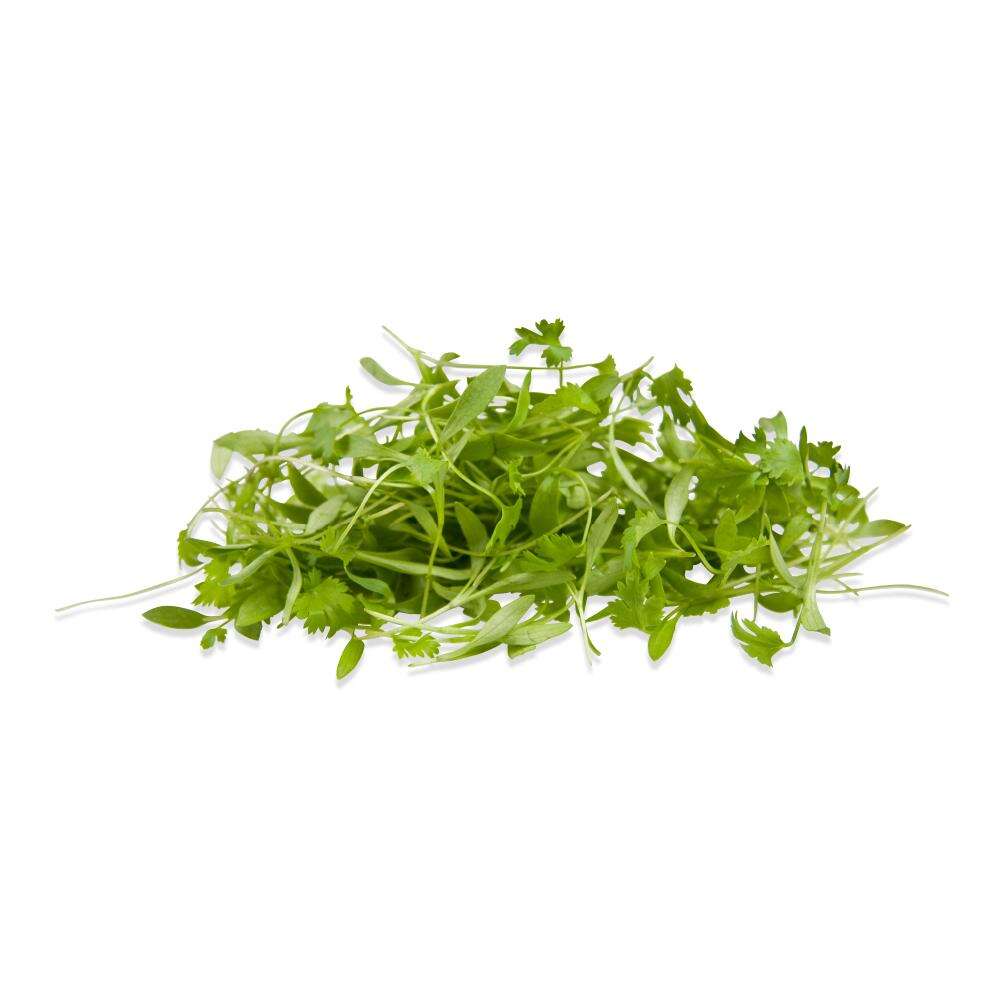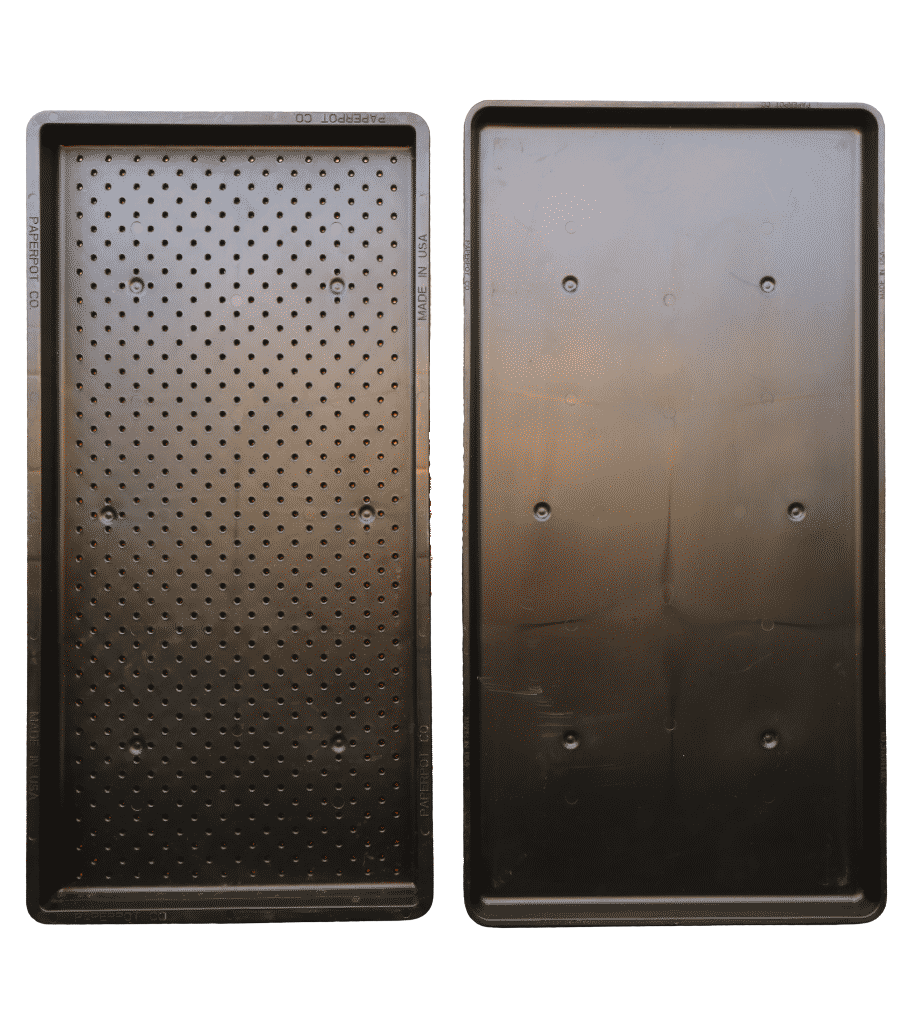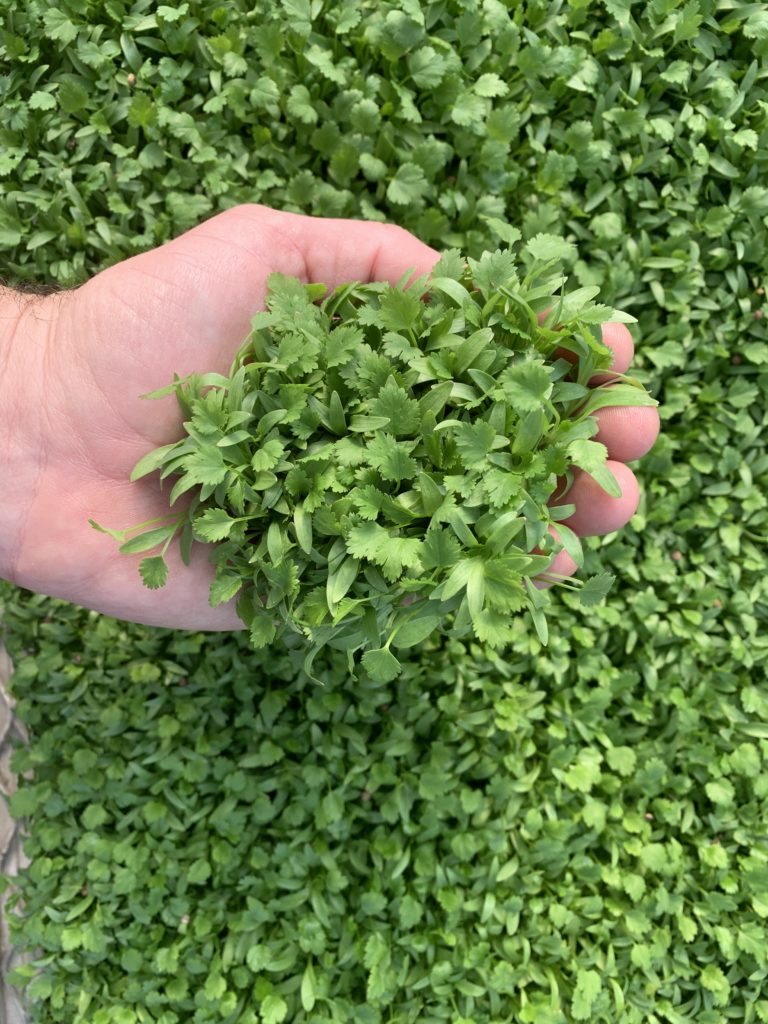Growing Cilantro Microgreens in Paperpot Trays


Growing Cilantro Microgreens in Paperpot Trays

Won’t bend or break!

Larger trays = higher yields!

Matching solid bottom trays for easy watering!
Growing microgreens in Paperpot Trays gives you over 30% more growing space than standard 1020 trays, and they’ll last you a lifetime without breaking. This prevents you from needing to dispose of cheap plastic trays after just a year or two. Paperpot Trays also have low-profile side walls for better air flow, and convenient thumb holes for bottom watering when used with matching solid bottom trays. When stacking Paperpot Trays for germinating microgreens, there is a small air gap between the soil surface and the tray above, greatly reducing mold issues!
Cilantro microgreens have a longer growth rate compared to some of the other faster-growing microgreens.
They have a sweet, bright aroma and in contrast to full-size cilantro, micro cilantro is slightly peppery with its distinct fresh flavor. Cilantro microgreens also contain vitamins A, C, K, as well as folate, potassium, and manganese.
Cilantro is a crop that many growers would consider tough to master because of its many challenges, such as the steep learning curve with watering—too much water and you’ll end up with poor germination rates, but too little and you’ll get a ton of seed hulls, and mold. Mold on cilantro is a losing battle. If you’re not careful, you’ll end up tossing the tray 99 percent of the time. It can take a lot of trial and error to grow cilantro well in your context.
Depending on your preference, the cilantro can be harvested after two weeks—yielding palm tree–looking microgreens that still taste like cilantro—or after three to four weeks, when the frilly true leaves come out, which many chefs like.
For some good research based information on the health benefits of microgreens, check out: The Institute of Food Technologists, Researchgate.net and Sciencedirect.com


The Specifications for Cilantro Microgreens
| CILANTRO MICROGREENS | Paperpot Trays (12" x 24") | Standard Trays (10" x 20") |
| RECOMMENDED CULTIVARS | Split seed cilantro | Split seed cilantro |
| DRY GRAMS PER TRAY | 42 g | 32 g |
| GERMINATION TIME (STACKED) | 7 days | 7 days |
| DAYS TO MATURITY | 21-25 days *time from seed to harvest | 21-25 days *time from seed to harvest |
| TARGET CROP YIELD PER TRAY | 315 g (+/-) | 240 g (+/-) |
| HARVEST UNIT | 105 g of product (+/-) per clamshell | 105 g of product (+/-) per clamshell |
| HARVEST UNITS PER TRAY | 3 (+/-) | 2.3 (+/-) |
| PRICE PER UNIT | $14 | $14 |
| REVENUE PER TRAY | $42 (+/-) | $32 (+/-) |
| TRAYS | Perforated top trays nested into solid bottom trays (Paperpot Trays or 1020’s) |
| GROWING MEDIUM | 80% peat moss, 20% perlite or vermiculite (nutrients/compost optional) |
| SEED SANITIZING | Sanidate 5.0 (1.6 oz to 5 gal. water), or Zerotol 2.0 (20 ml to 2 L of water), or 1:1 white vinegar and hydrogen peroxide |
| SHELVING | NSF Wire Shelving Racks: 60"x24"x72" fits four Paperpot trays per shelf, 48”x18”x72” fits four 1020 trays per shelf. *Add a 6th shelf to these 5-tier racks to fit five grow shelves, 12” between shelves. |
| LIGHTING | 4’ T5 LED Barina Lights - 3 per 24” deep shelf (2 per 18” deep shelf) |
| VENTILATION | Desktop computer fans (2 per shelf), or standing fan next to rack |
| HARVEST | Well sharpened kitchen knife |
| PACKAGING | Clamshells (or plastic bags), farm logo stickers |
| POST HARVEST | White vinegar, hydrogen peroxide, or Zerotol 2.0 (food grade hydrogen peroxide concentrate), 2 Liter pump spray bottle. |

Suggested Tools & Supplies
The best growing medium consistency for microgreens is composed of fine particulates with eve drainage. Too much drainage will lead to dehydrated crops, and too little drainage will lead to fungal issues.
Clumpy mix can be loosened up by hand when adding to your filling bin. Mix with larger particulates can be sifted through a DIY sifter made from 1/4” wire mesh on a box frame. This can be placed over a wheel barrow or tote to sift our larger material that may inhibit germination.
When filling trays with growing medium, make sure to spread it evenly in the corners and edges of the tray or microgreens in those areas will become dehydrated and tend to fall over.
After spreading the growing medium evenly in the tray, use a custom wooden press, or an empty tray to tamp/press the soil, creating a smooth even surface.
Spray down the growing medium with water prior to seeding.

Soil & Tray Preparation

Seeding & Germinating
Sprinkle the seeds evenly over the tray, then water generously.
A top covering of vermiculite helps to improve and even out cilantro’s germination rates. The abrasive vermiculite also helps to remove most of the seed hulls once the cilantro begins to grow. Mist down the vermiculite after spreading it to hold it in place.
Seeded trays can be stacked up to six at a time, with an empty seventh tray at the top. Place a 14 lb paver on the top to weight down the trays, encouraging strong stems and vigorous growth.
Germinating trays do well at 70° and can be stacked in racks with no lights.
Cilantro stays stacked and covered for 7 days. Periodically misting the top layer of vermiculite during this time will help soften the seed hulls, encouraging them to fall off rather than stick.
After unstacking the trays, give them a thorough watering, and move them to the light.
Transfer the trays to the grow racks under the lights, nesting them into the solid bottom trays.
16 hours of light per day is recommended for microgreens.
At this point, watering can be done by lifting the top tray by the thumbhole and pouring water straight into the bottom tray. Paperpot bottom trays have a line that provides a convenient reference point for how much water to add.
Bottom watering should take place once every morning. If your growing medium does not retain its moisture as long, water once more in the evening.
Depending on your preference, cilantro can be harvested after two weeks, yielding palm tree looking microgreens that still taste like cilantro, or after three to four weeks, when the frilly true leaves come out which many chefs like.
Stop watering 24-48 hours prior to harvest to ensure crops are dry and free from excess moisture. This helps greatly to extend the shelf life of the microgreens.

Growing & Watering

Harvesting & Packaging
Wash hands thoroughly and/or wear latex gloves before handling greens for harvest.
Sharpen the harvesting knife each time prior to harvest. To harvest, grab a handful of microgreens and cut just high enough above the growing medium to ensure there isn’t any stuck on the ends of the greens.
Carefully place the greens directly into the clamshells.
Scintilla Farms tip: place the clamshells into the refrigerator with the lids open for the first 10-15 minutes to avoid build up of moisture (after which they can be closed). This can increase shelf life.
Dump the harvested tray’s soil and root matter into bins or wheel barrows to be taken to compost.
Rinse, then spray down the tops and bottoms of the trays with 20ml of Zerotol 2.0 to a 2 Liter pump spray bottle of water, or a 1:1 hydrogen peroxide, white vinegar solution. Allow trays to dry in a rack prior to being reused.

Post Harvest & Tray Sanitizing
Paperpot Trays are a wise choice for growers serious about growing microgreens for profit.
Durability, longevity, higher yields, and increased air flow, are just some of the reasons why growing microgreens in Paperpot Trays makes so much sense.
Get started growing Cilantro Microgreens in Paperpot Trays and download the Growers Notes below.
DOWNLOAD ALL OF THE MICROGREENS GROWERS NOTES
- Amaranth Microgreens
- Arugula Microgreens
- Cilantro Microgreens
- Green Shiso Microgreens
- Leek Microgreens
- Nasturtium Microgreens
- Pea Shoot Microgreens
- Radish Microgreens
- Sunflower Microgreens
The Microgreens Growers Notes were developed in partnership with Scintilla Farms and Seth Davis.
INTERESTED IN PURCHASING?
If you have any questions, please reach out hello@paperpot.co or 877.850.1555.
